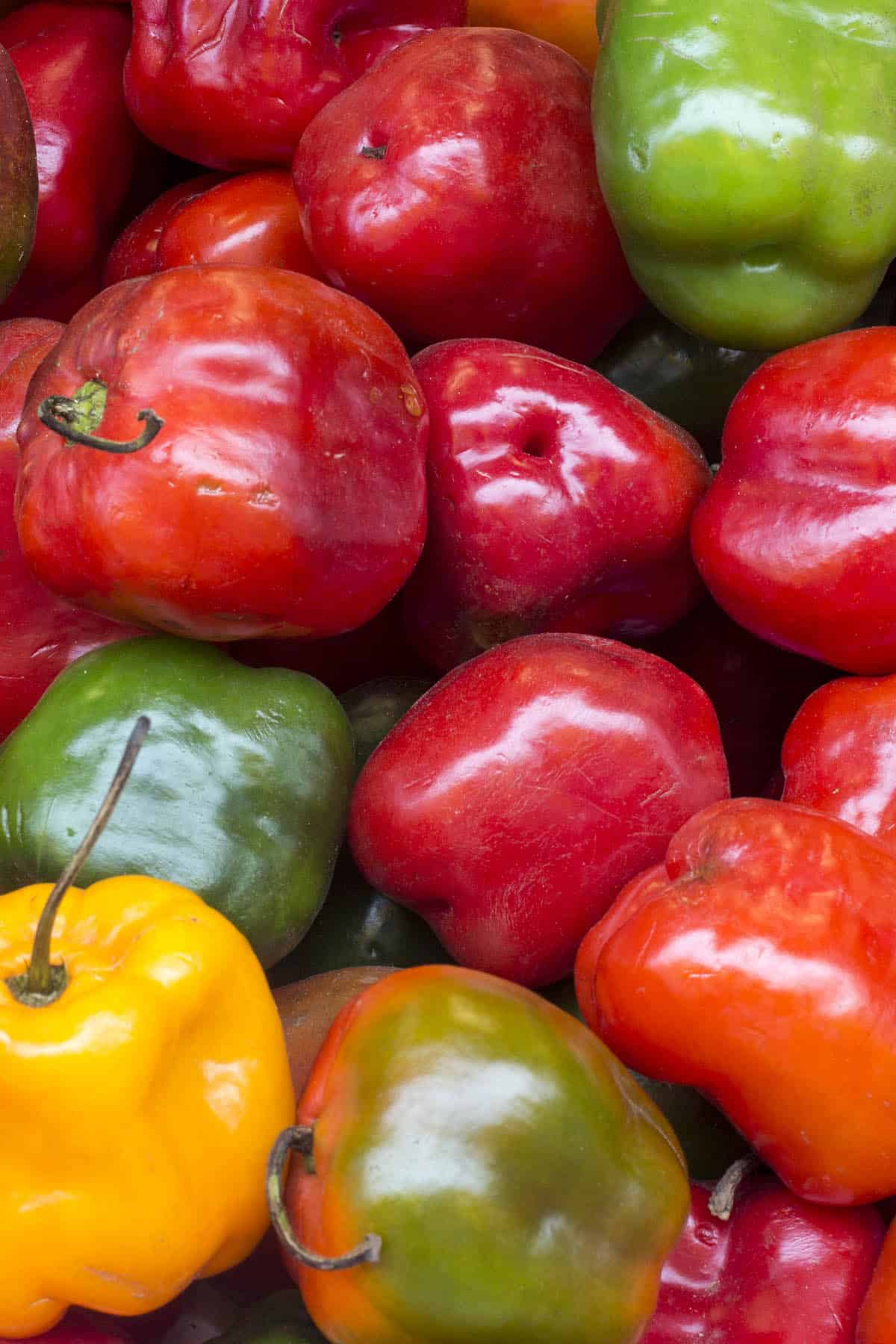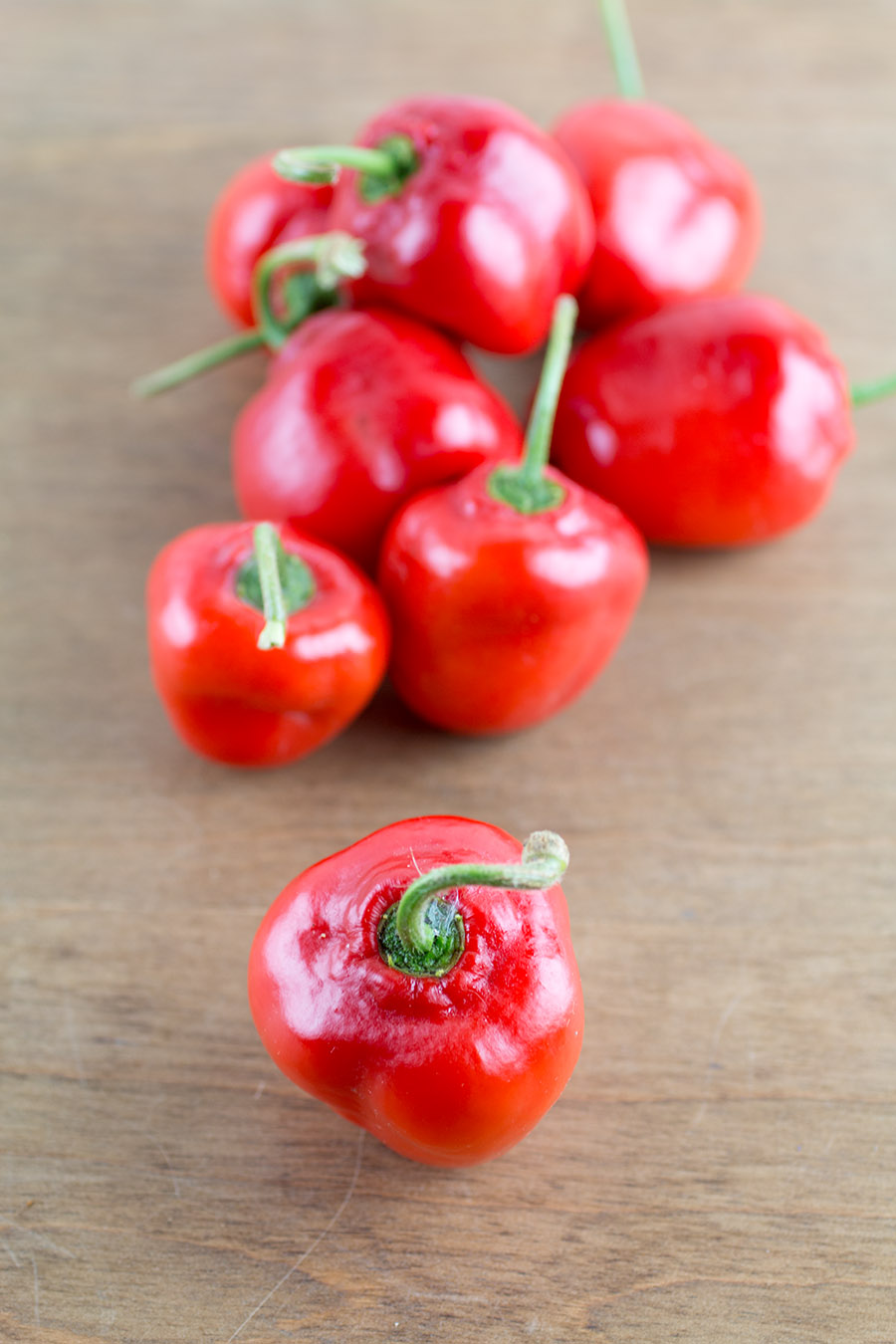The rocoto pepper is an apple or pear shaped pepper similar in appearance to a small bell pepper, but this pepper packs a nice level of heat and great flavor. Learn more about it.

Scoville Heat Units: 30,000 - 100,000 SHU
Capsicum Pubescens
The Rocoto Pepper grows in the Andes mountains from Chile to Colombia, as well as in the highlands of Central America and Mexico. It is native to Peru.
It goes by many names including the "locoto pepper" widespread through South America, or as the "rocote", or as the "caballo pepper" or "horse" in Guatemala and some parts of Mexico.
It is also known in Bolivia and Peru and in Mexico as the manzano/manzana (though they are not the same pepper) or "apple pepper" in one variety resembling small apples and often used when red, or as perón or "pear pepper," once again in Mexico and in allusion to its especially fruity or even sometimes green appearance.
They are called "canario" or "canary" pepper when referring to the yellow variety, particularly in Oaxaca.
They are further known as "cera" and "malinalco", or "ciruelo", as well as "cirhuleo" in Querétaro, a state in central Mexico.
It is among the oldest of domesticated chili peppers in the Americas, and was possibly domesticated as early as 6,000 BCE; some scientists even now agree that its domesticated form is so old and prevalent that its original wild form is now totally extinct.
How Hot is a Rocoto Pepper?
Rocoto peppers are known to be quite hot peppers, reaching up to 100,000 Scoville Heat Units on the Scoville Scale. Compare their heat level with the popular jalapeno pepper and you'll find the hottest rocoto is about 20 times hotter than the average jalapeno.
This would put the hottest rocoto on par with a low level habanero pepper. What a nice level of heat! They are similar in heat to certain Thai peppers, or bird's eye peppers or chiltepin peppers.
Rocoto Pepper Vs. Manzano
As mentioned above, some areas use the name "manzano" when referring to rocoto peppers, however, they are not the same peppers. While similar, rocoto peppers are more common to the Andes, reaching further south, and can be quite a bit hotter than manzano peppers.
Rocoto Peppers Size and Appearance
The pepper plant's size varies widely and can reach vine-like from a common expanse of 2 feet in the United States to a whopping in 15 feet in Bolivia, and the round or pear-shaped pods can grow from 2 to 3 inches in length.
The peppers have a thick walls similar to a bell pepper, with black seeds, and can found in a variety of colors from vibrant red to yellow and orange.
Cooking with Rocoto Peppers
Rocoto peppers are important to Bolivian and Peruvian cuisine. These peppers tend to get consumed while fresh because of the thickness of the pods making them hard to dry properly.
They also appear in hot sauces and spicy salsas, or feature as rocotos rellenos when prepared as stuffed and baked dishes including meats and cheeses. I enjoy using rocoto peppers for making ceviche, for their nice level of heat.

Learn About These Other Medium-Hot Chili Peppers
- Shipkas Chili Peppers
- Hidalgo Chili Peppers
- Bolivian Rainbow Chili Peppers
- Jwala Finger Hot Chili Peppers
- Super Chili Chili Peppers
- Dundicut Chili Peppers
- New Mex XX Hot Chili Peppers
- Diablo Grande Chili Peppers
- Charleston Hot Chili Peppers
- Red Amazon Chili Peppers
- Yatsafusa Chili Peppers
- Moshi Chili Pepper
- Peter Peppers: The Oddly Shaped Chili Pepper
- Fish Peppers
- Bishop's Crown Peppers: All About Them
- Guntur Sannam Chili Peppers
- Santaka Chili Peppers
- Malagueta Chili Peppers
- Manzano Peppers: All About Them
- Aji Cristal Peppers - Info, Seeds and More
- There are even more here!
NOTE: This recipe was updated on 8/24/21 to include new information. It was originally published on 9/27/13.


Ingrid Ugarteche says
Does anyone knows where I can purchase in the US?
Mike Hultquist says
You can check out my resources page: https://www.chilipeppermadness.com/resources/
Derek Jacombs says
Currently - for some reason - widely available in New Zealand supermarkets!
Mike H. says
Great opportunity to get a batch and go crazy with'em!
Colin says
Derek, is that you from Kokomo?
Cheers, Colin
Charles Tomianovic says
Haha, good joke, I was rushing to Costco to buy some rocotos.
Catherine says
A few years ago we were given a bag of hot peppers by my husband’s coworker. The coworker’s mother was given the plant by her postman because she had a green thumb. The special thing about them was that they were grown in one of the foggiest neighborhoods in foggy San Francisco. The coworkers family thought they were too hot however. We made a delicious fermented hot sauce from them and saved the seeds. We now have a great big shrub producing lots of peppers. We thought they must have been a spontaneous pepper hybrid because SF is known to be an almost impossible place to grow peppers. They did poorly in our son’s garden in hot central California where other peppers grow like crazy. Today I was in a funky native plant outdoor store where the owner was growing our peppers! Finally we know what they are. I was very glad to find your information here about what they are (but a little sad to find out that we don’t have a previously unknown species!).
Mike H. says
Catherine, thank you for sharing your interesting story. It must be nice to find out what the peppers are, but I can see why you miss the mystery behind them. Perhaps it's time to get another bag of unknown peppers from the same neighborhoods? 😉
Maureen says
These peppers grow well in SF Bay area. I got a plant from a nursery years ago in Oakland and it was labeled 'manzana roja'. Grew like a big bush and very prolific with very hot peppers. I saved seeds from one because I was going to be moving (nearby) and was able to get 2 more plants to germinate. These have been going for more than 8 years. I have so many peppers from them that I have to put them out in a box I have for neighbors to take, but I always label them as very hot (one Mexican friend says she can only use half of one for her regular batch of salsa).
Warren Pretorius says
loved the article.
Libby Ibell says
We have grown Rocotto very successfully in Christchurch, New Zealand. We have grown one in the glasshouse for around two years now and if fruits most of the year (i would say we would get 50-60 fruit each year). It even survived after a -2 frost blackened and wizened it up.
We have a fairly dry climate with cold winters ( a lot of frosts that become sunny days after the cold start) and dry warm(ish) days in summer. This year we grew one in summer outside but is certainly hasn’t been the success the glasshouse chilli has been ( but all round it has not been a good year for our outdoor chilies).
The taste is great- hot- but not too much so and we freeze whole and use to make sauces and other condiments.
Alan says
sorry to revive a dead article, but I'm going to try to grow them myself! do you think it would be possible to grow indoors? does it grow like a bush or vine? how big did yours get?
Wayne C says
I have been growing rocoto in Tasmania for some years now. They fruited 2nd year in the hot house but 3rd year outside in the ground. We get mild winter frosts and mild summers so nothing spectacular in the weather. Although I prune by around half to a third of the growth of each Autumn the plants grow as a bush and by the third year are over a meter round, not very dense and a little spindly. The hothouse plants need some support as they tend to have longer branches, but outside they are a more compact and self supporting bush.
Greg says
I have two rescued ones (local store was drowning them to the point the leaves were yellow) growing in a greenhouse and they are doing well, I think they look closer to a vine than a bush.
Godfrey Weir says
I brought one home from Costco, cooked it and froze into small cubes. Subsequently I used 3 small cubes in about a litre of chicken and mushroom soup. The spicyness came through very subtly, just enough to warm the brow!!
Can really recommend this addition but where can one buy Rocoto in Norther England?
Godfrey Weir says
Please note Costco should read Cusco in Peru
Finger slip!
Mike Hultquist says
Yes, great peppers, Godfrey. I wish I knew where you could buy them. Often times, people need to grow these peppers, as they can be hard to find. Consider a farmers market.
Memph says
You'll probably need to buy seeds - garden centers don't sell special varieties like these. I'm in Canada and got my seeds from Atlantic Pepper Seeds, but there are other suppliers that are US based too. I'm not familiar with the British market but I would think you can find something online.
Warning though, the plants take a long time to produce, and they also get very large. I started mine under grow lights in early March, planted them in-ground in early June, and we got our first frost a couple days ago and only 1-2 ripe fruits per plant - even though the plants are 6ft tall and wide. The "commonly 2ft in the US" seems inaccurate - mine are 3x that size and I'm in southern Canada... I've dug them up and halfway pruned them back so that they could be brought inside for protection against the frost, and now that it's warmed back up maybe they can ripen a bit more. After that, I'll try growing them a bit in the attic where there's a skylight and it's warmer than outside. But eventually I think they'll have to go dormant for the winter and get pruned back further.
Hopefully next year they can produce sooner thanks to being more established. I'm hoping I can start hardening them off earlier than the other varieties this spring, thanks to the fact that they're more cold tolerant. Not that they handle freezes well, but as I understand, they aren't as prone as other species to disease or going dormant when temperatures are 5-10C.
Mike H. says
Fingers crossed, Memph. Let me know how it goes!
Carol Bruntom says
use your own stock for seeds. I just take seeds out and replant. they are beautiful chillies very hot
Paul:-) says
I found some dried ones in Sainsbury’s
Richard Young says
Hello Godfrey
I can supply you free seeds or possibly a plant of Rocoto if you’re still interested. I’m in Newcastle upon Tyne: richardgyoung@proton.me